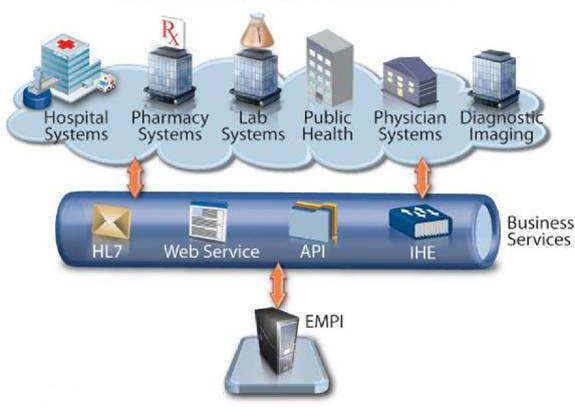
Out of the box, the EMPI metadata model saves names, nicknames/aliases, general demographics [gender, date of birth (DOB), ethnicity, marital status, religion, etc.], multiple ID numbers, addresses, phone numbers, credit card numbers, and much more. Adding any fields that we do not already have takes just a few minutes in our graphical user interface (GUI) tool.
Adapted specifically for health care environments, an EMPI tracks patient records among systems in a network. It contains deterministic and probabilistic matching algorithms to provide an extremely high level of accuracy when matching records. This solution enables medical professionals to establish a “single patient view” providing a full picture of the interactions with each patient drawing from data that may be stored within a range of systems across the network.
Record matching is handled through a combination of approaches. Whereas accuracy is the primary objective, we place great importance on response times, availability, and scalability.
The EMPI allows for easy data reconciliation across two or more sources. Events that take place within the EMPI (adds, updates, linkages, de-linkages, deletes, etc.) trigger an outbound message detailing the event and record(s) involved. These messages are received (transformed if necessary) and routed out by an integration engine or ESB.
EMPI Implementation Methodology
HealthIT2 deploys a robust methodology for implementing EMPI. This has been developed over the many years that we have deployed and maintained environments for healthcare customers. HealthIT2’s goal is to work with clients to identify the appropriate implementation approach to meet your business, technical and budgetary needs. After an initial assessment, we will schedule an onsite meeting for two to three days to review the technical environment, timelines, staffing availability and meet with the key business owners. This will include a Healthcare Subject Matter expert, the potential Project Manager and a HealthIT2 architect. Following this we will present you with a formal Statement of Work on which we will base our engagement. The following phases are included in typical EMPI implementations
Project Planning
This is a planning phase that involves the Project Managers from both the client organization and HealthIT2. They work together, both remotely and onsite, to finalize the plans, insure all logistics are in place and orchestrate appropriate resources from all participants.
Project Kick Off
Generally a one-day event which is also the beginning of the Architecting phase. This brings together all key players, clearly states the goals of the project and defines the roles and responsibilities of the project team members.
Architecture Phase
This is the most critical phase of the project. From our initial review of your requirements, we would anticipate a thorough review of all of your current systems and technical environments. We would also develop a detailed architecture and design for the implementation of all interfaces. Participants would include all key technical and business owners involved in the project. Management will be included to clearly define the business drivers and strategies. Additional training requirements and schedules will be determined during the analysis and design process.
Data analysis, profiling and cleansing are essential first steps towards managing the quality of data in a master index system. Performing these processes early in the project helps ensure the success of the project and can eliminate surprises down the road. EMPI’s typically provide the tools needed to analyze, profile, cleanse, and standardize legacy data before loading it into a master index database – if not, we can supply these tools on our own. Cleansed data profiles are generated from a master index application, and they use the object definition and configuration of the master index application to validate, transform, and standardize data.
Read details on Data Analysis, Profiling and Cleansing.
Initial Bulk Match and Loading
During this phase, we use our tools to analyze match logic, match legacy data, and load a large volume of data into a master index application. One of the issues that arises during a data management deployment is how to get a large volume of legacy data into the master index database quickly and with little downtime, while at the same time cleansing the data, reducing data duplication, and reducing errors. Our tools provide a scalable solution that standardizes and matches raw data and that can be run on multiple processors for better performance.
Interface Development
Depending on the organization’s requirements for real-time interfaces to maintain or add master index objects to the EMPI database, HealthIT2 will assist the client or develop the required interfaces, using the Master Index application’s API. EMPI’s provide a number of methods to communicate with the master index, including messaging, Web Services and Java API.

